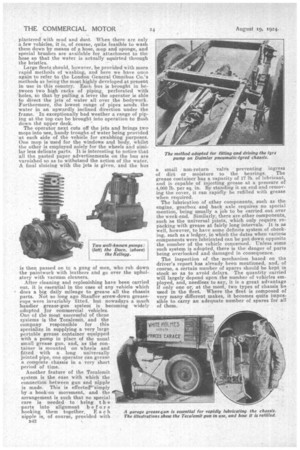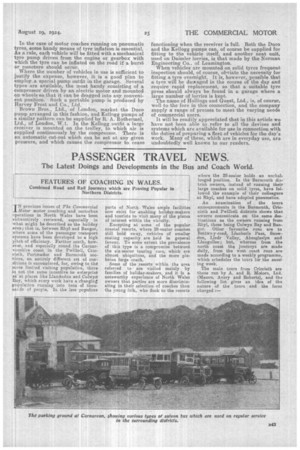PREPARING FOR THE DAY'S WORK.
Page 23

Page 24

Page 25

If you've noticed an error in this article please click here to report it so we can fix it.
Time-saving Methods and Devices for the Rapid Reconditioning of a Fleet Overnight, Replenishing, Greasing, Cleaning and Attention to Tyres.
ECONOMICALLY it is, of course, a sound policy to keep a fleet working for as many hours out of the 24 as is possible, but when this principle can be adhered to the result is that very little time remains for keeping the vehicles in the pink of condition. Furthermore, owing to the big daily mileage which they will c'over, it becomes essential to adopt some standardized system of mechanical inspection,
and this has also to be crowded into the few hours available.
Buses used on regular town routes are, perhaps, the hardest worked of any commercial vehicles, covering, as they do, some 120 miles in the course of an 18-hour day. Conditions almost as strenuous are, however, met with in motor coach work during the summer season, and in the case of delivery vans operating over a large radius. As regards the lorry proprietor, it is not, unfortunately, very often that he has sufficient work on hand to keep his vehicles going more than 10 hours or II hours out of the 24; on the other band, he will not, in all probability, consider it worth while to employ a night shift, so that the necessary work on the lorries must be undertaken each morning before they are sent out.
Regular Inspection Obviates Breakdowns.
The time factor is, therefore, equally as important in this case also, only a limited period being available in which to carry out the necessary. work. Incidentally, it may be pointed out that, whilst a lorry, bus, van or coach can be made to work day after day with but little attention, it is by far the better plan to institute a regular system of nightly conditioning, because, in the long run, this will reduce the cost of repairs and lessen the liability to breakdowns on the road.
The same argument applies to the bodywork of passenger vehicles,. because if dust or dirt be allowed to settle on the pamtwork for days on end, it cannot be removed without damaging the surface, so that the vehicle soon begins to look shabby. A smart appearance is, of course, a very essential point in motor coach and buswork, and clean upholstery is equally important. Apart from this, frequent repaint
ing will be necessary if the bodywork be not properly looked after. .
If the fleet be of a sufficient size to warrant such a system, it is undoubtedly a good plan to make each driver, on reaching the garage at night, fill up a form concerning the mechanical condition of his vehicle. In order to save time, this forth may well be divided into columns headed : "Engine," " Gearbox " " Final drive," " Steerima. gear," " Brakes,'' etc.' In the spaces provided the driver can then insert " O.K.," or any other comment which he thinks it necessary to make. This sheet Would then be passed on to the fitter, who, during the night, would be expected to examine every component reported as faulty and adjust them before the vehicle went out for another clay's work.
Such a.System has, of course, been brought to perfection by the London General Omnibus Co., Ltd., with the result that hardly ever does one see a bus belonging to this company held up on the road. In addition to the nightly inspection system, each vehicle is given a thorough inspection once a month, and, as our readers are well aware, every bus undergoes an annual stripping and complete overhaul at the Chiswick works.
Replenishing the Tank.
Supposing that the driver has filled in his report sheet, the vehicle will next require replenishing with petrol and water. The fuel should, of course, be kept in underground storage tanks and measured into the tank on the vehicle. In order to avoid waste and to save time, there should be a gauge to show the quantity of petrol remaining in the tank of the vehicle, and next to this might well be fixed a plate indicating the total capacity. Thus, supposing the gauge showed two gallons remaining and the marked capacity was 20 gallons, the operator would at once know that 18 gallons were required fully to. replenish the tank.
Next in order comes the question of washing down, which, as already pointed out., is essential in the case of passenger vehicles, but is not generally considered to be of much moment in the case of lorries. How-every, the condition of a lorry used even an such work as conveying road materials will repay a little. attention in this direction, because . it is impossible to inspect and lubricate the working parts if they be
plastered with mud and dust. When there are only a few vehicles, it is, of course, quite feasible to wash them down by means of a hose, mop and sponge, and special brushes are available for attachment to the hose so that the water is actually squirted through the bristles.
Large fleets should, however, be provided with more rapid methods of washing, and here we have once again to refer to the London General Omnibus Co.'s methods as being the most highly developed at present in use in this country. Ezu h bus is brought in between two high racks of piping, perforated with 'holes, so that by pulling a lever the operator is able to direct the jets of water all over the bodywork. Furthermore, the lowest range of pipes sends the water in an upwardly inclined direction under the frame. In exceptionally bad weather a range of piping at the top can be brought into operation to flush down thd upper deck.
The operator next cuts off the jets and brings two mops into use, handy troughs of water being provided at each side of the vehicle for swabbing purposes. One mop is used for the windows and body, whilst the other is employed solely for the wheels and similar less delicate parts. It is interesting to notice that all the pasted paper advertisements on the bus are varnished so as to withstand the action of the water. A final sluicing with the jets is given, and the bus
is then passed on to a gang of men, who rub down the paintwork with leathers and go over the upholstery with vacuum cleaners.
Another feature of the Tecalemit system is the ease with which the connection between gun and nipple is made. This is effected. simply by a hook-on movement, and the arrangement is such that no special care is needed to bring t h e parts into alignment be f ore hooking them together. F ach nipple ia, of course, provided with
B42
a small non-return valve preventing ingress of dirt or moisture to the bearings.The grease container has a capacity of 17 lb. of lubricant, and is capable of injecting grease at a pressure of 4,000 lb. per sq. in. By standing it on end and removing the cover, it can rapidly be refilled with grease when required. The lubrication of other components, such as the engine, gearbox and back axle requires no special mention, being usually a job to be carried out over the week-end. Similarly, there are other components, such as the universal joints, which only require rep-acking with grease at fairly long intervals. It is as well, however, to have some definite system of checking, such as a'ledger, in which the dates when various components were lubricated can be put down opposite the number of the vehicle concerned. Unless some such system is adopted, there is the danger of parts being overlooked and damaged in consequence.
The inspection of the mechanism based on the driver's report has already been mentioned, and, of course, a certain number of spares should be kept in stock so as to avoid delays. The quantity carried will largely depend upon the number of vehicles employed, and, needless to say, it is a great advantage if only one or, at the most, two types of chassis be used in the fleet. Where the fleet is composed of very many different makes, it becomes quite impossible to carry an adequate number of spares for all of them. In the case of motor coaches running on pneumatic tyres, some handy means of tyre inflation is essential. As a rule, each vehicle will be fitted with a mechanical tyre pump driven from the engine or gearbox with which the tyre can be inflated on the road if a burst or puncture should occur. Where the number of vehicles in use is sufficient to justify the expense, however, it is a good plan to i employ a special pump outfit n the garage. Several types are available, the most handy consisting of a compressor driven by an electric motor and mounted on wheels o.that it can be dragged into any convenient position. Such a portable pump is produced by Harvey Frost and Co., Ltd. Brown Bros., Ltd., of London, market the Duco pump arranged in this fashion, and Kellogg pumps of a similar pattern can be supplied by R. A. Rothermel, Ltd., of London, W.l. In the Kellogg outfit a large receiver is mounted on the trolley, to which air is supplied continuously by the compressor. There is an automatic cut-out which can be set at any given pressure, and which causes the compressor to cease functioning when the receiver is full. Both the Duco and the Kellogg pumps can, of course be supplied for fitting to the vehicle itself, and another neat unit, used on Daimler lorries, is that made by the Norman Engineering Co.. of Leamington.
When vehicles-are mounted on solid tyres frequent inspection should, of course, obviate the necessity for fitting a tyre overnight. It is, however, possible that a tyre will be data-aged in the course of the day and require rapid replacement, so that a suitable tyre press should always be found in a garage where a large number of lorries is kept.
The name of Hollings and Guest, Ltd., is, of course, well to the fore in this connection, and, the company supply a range of presses to meet the varying needs of commercial users.
It will be readily appreciated that in this article we have not been able to refer to all the devices and systems which are available for use in connection withthe duties of preparing a fleet of vehicles for the day's work. Many of these, which are in everyday use, are undoubtedly well known to our readers.






























